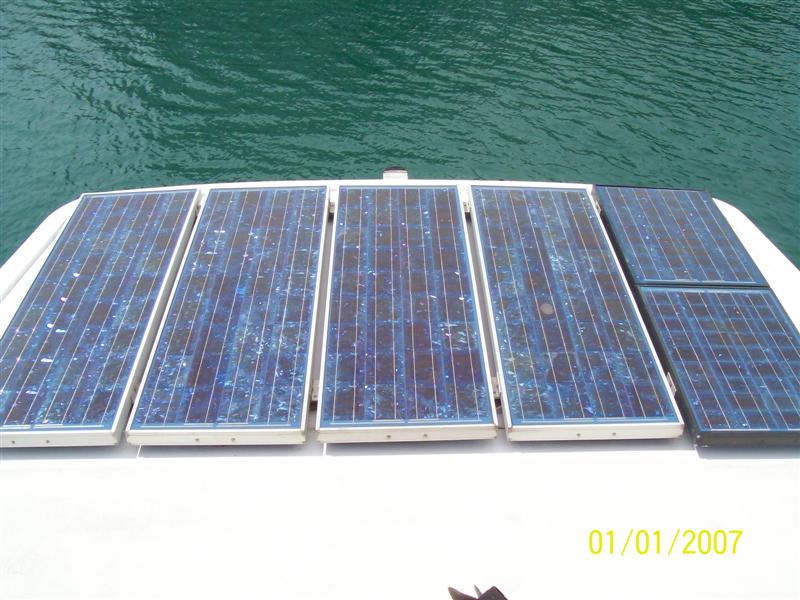 One of the advantages of a powerboat over a sailing boat for solar energy collection is the large roof unobstructed by rigging and sails.*
One of the advantages of a powerboat over a sailing boat for solar energy collection is the large roof unobstructed by rigging and sails.* Because we planned to cruise in truly isolated locations (northern Australia and eastern Indonesia) and in some Southeast Asian countries where repairs, replacements and expertise wouldn’t be available and marinas few and far between, Lifeline needed to be designed to be self sufficient. Able to exist almost indefinitely on anchor, without needing to find a dock to get eletricity, water or a shower. This had implications for the design of our electrical power system. It needed to be simple, robust, maintenance free, with no requirement for human intervention. In short, we needed AN ELECTRICAL SYSTEM FOR LONG TERM, LONG RANGE, OFF-THE-BEATEN-TRACK CRUISING......
It is now March 2011. Nearly 10 years since Philip and I started cruising on board M.V. Lifeline; 6 years since we left Australia for Southeast Asia. In that time Lifeline’s electrical system has performed – 24 hours a day – almost flawlessly. It is certainly one of the hardest working and most used systems on the boat.
Lifeline’s system is somewhat unusual for either a powerboat or sailing boat. This is because it combines a low power usage philosophy (usually the preserve of sailboat cruisers) with 240 volt house supply through an always-on inverter (usually the preserve of power cruisers). Unusually for a powerboat, Lifeline does not run a generator but rather relies on solar to supply all power when not motoring (99% of the time). (It also has a few other features often not found on boats, but we’ll come to those later.)
The approach of most powerboats and many sailing yachts these days, on the other hand, is to have all the comforts of home and run a generator to power it all. This is certainly an option, but a high maintenance one – perhaps not suited to those who want to cruise far from home or get off the beaten track.
Why not a generator? There are certain items of marine equipment that are infamous amongst cruisers for breaking down. One that’s high on the list is the marine generator (along with the marine toilet, watermaker and eutectic refrigeration). If you go this way you’d better like engine repair and maintenance or searching for someone who does. We don't.
“Philosophy”?….. In designing something as prosaic as an electrical system? Well, yes, because unlike with a house, where 240v power supply is just hooked up and standard systems apply, on a boat there are options and the options you choose affect how you can use your boat and your lifestyle on board.
When we re-designed Lifeline for cruising, we tried to apply all our knowledge of how cruising life really works. We’d always thought that if you don’t do it right, it’s possible for your boat systems to run you rather than you running your boat systems.
I’ll give you an example. Many boats that cruise away from shore facilities for long periods of time use “eutectic refrigeration”. This is a system whereby a cold plate in a fridge box is “taken down” to very cold (sub minus) temperatures once or twice a day by using a generator or the boat engine. Throughout the rest of the day the plate/box gradually rises in temperature, until it is “taken down” again the next day (or, more usually, a second time that evening). This process provides large amounts of cold and on the surface looks a good way to provide a boat with refrigeration.
But the disadvantage with this sort of system (apart from its legendary propensity to stuff up) is that someone – a real human – has to be there to run an engine at the right time to keep all that cold cold. In practice this means that someone has to stay on board with the engine running (usually for 1- 2 hours) at some time EVERY DAY. No staying in town late for a concert or taking off for a few days without finding someone to babysit the fridge. And you may also face the ridiculous situation of having to run an engine for the fridge even when in a marina hooked up to shore power.
We wanted to be independent of marinas and other boats but I was keen to have a boat that on the inside resembled a house as far as possible and was as easy to use as one. We wanted a TV, DVD, Hi-Fi, our laptops, mood lighting, cooling, and refrigeration etc but we didn’t want it at the cost of having to either hook up to shore power or run a generator.
So, as always happens on a boat, we had to compromise. We came to the same conclusion that sailing boat cruisers do: you can’t have the big power suckers! Any thing that makes heat or cold (eg microwave oven, bread maker, electric jug, toaster, hair dryer, air conditioner) generally falls into this category. (This isn’t to say you can’t carry these aboard to use when on shore power – we do – just that they can’t be part of the everyday setup when you have a low power budget.)
I also didn’t want a mess of wires and plugs running 12 volt, 24 volt, 240 volt all over the boat or even a mixture of plugs just waiting for me to use the wrong voltage and blow the thing up. And we definitely wanted efficient power usage.
All of the above led logically to a number of important decisions in the way we set up the electrics for our boat. And because we were lucky enough to have our boatsmart electrical engineer friend Leon doing it for us, the decisions resulted in a smart, neat, failsafe, documented(!) system that works just the way we want and can be understood even by techno-cretins like me.
One of the first things Leon did in designing our system was to draw up a table of all the electricity-using equipment we had on board, how many amps it drew when operating, how long it operated each day and the total estimated daily amp. use figure. With a decent sized margin for higher usage, he then over-estimated the battery capacity required (so we were unlikely to run our batteries down to less than half, thus shortening their life) and the number and size of solar panels needed to generate that amount of electricity.
He had to set up 12, 24 and 240volt circuits as, apart from the house electrics, which were going to be 240 volt (standard voltage in Australia and Southeast Asia), Lifeline came with both 12 and 24 volt electronic equipment.
Using 240v household lights, sconces, lamps, light switches and appliances etc meant we could easily find low wattage globes, allowing us greater efficiency than a 12 or 24 volt system. For example our reading spot lamps are 5w, our overhead lights are 9w. On the other hand, the smallest 24 volt globe we could buy was 20w. Lower wattages mean lower amp usage over a given period of time. (Ten years later in 2011, LED globes are becoming increasingly available for 12 and 24 volt lights but they are still not common. They also at this stage, give a harsh white light, compared with a warm white low wattage fluorescent.)
One of the much loved extras Leon left us, courtesy of his background and systematic train of thought, was an electrical system where each wire is numbered and neatly bundled, all circuits are diagrammed and described and all wires come back logically to the switchboard.
(*A Note About the Photos Below: Although these photos are dated 2007...I actually took them today, 27 March 2011...I didn't set the date on my camera properly....I told you I was a technocretin....and also too lazy to re-take the photos) ...
Power Generation
Power is generated by an array of 4 x 80watt solar panels that feed the engine starting/house batteries and 2 x 60watt solar panels that feed the emergency battery bank. Located on the deckhouse roof they are shade free and so are very efficient. A Plasmatronics Solar Controller regulates them and allows monitoring of charging, and battery voltage. A Link 10 monitor at the helm station keeps track of battery voltage, amp usage and power “remaining”. In practice the solar panels usually fully charge the battery banks by the middle of the day.
 One of the advantages of a powerboat over a sailing boat for solar energy collection is the large roof unobstructed by rigging and sails.*
One of the advantages of a powerboat over a sailing boat for solar energy collection is the large roof unobstructed by rigging and sails.*
Like everything else on Lifeline we tried to keep it simple and easily replaceable even in out of the way places. Generated electricity is stored in two banks of wet cell batteries: the house bank of 4 x N200 truck batteries (capacity 800 amps at 24 volts) and the emergency bank of 2 x N150 (300 amps at 24 volts). A master switch allows switching between banks as well as on and off. Under our set up, the house bank runs everything (engine starting as well as electrics) while the emergency bank stays topped up just for emergencies. The only thing that is wired to that bank are the electric bilge pumps. Philip wanted it this way, rather than the more common “one bank for engine starting” and “one for the house” because he didn’t want to have to remember to switch between banks for charging when underway. We never draw more than between a quarter and a half of the amperage in our battery bank, this has worked ideally for nearly 10 years.
Having wet cell rather than gel batteries means they have to be checked and topped up regularly (once a month on Lifeline) but it means batteries are available inexpensively anywhere here in Southeast Asia.
Lifeline generates, stores and supplies electricity at 24 volts but also converts power to 12 volts for electronic instruments (via a converter) and 240 volts for all house electricity (via an inverter which is constantly on). There are a number of advantages to having all the house energy supplied at 240 volts:
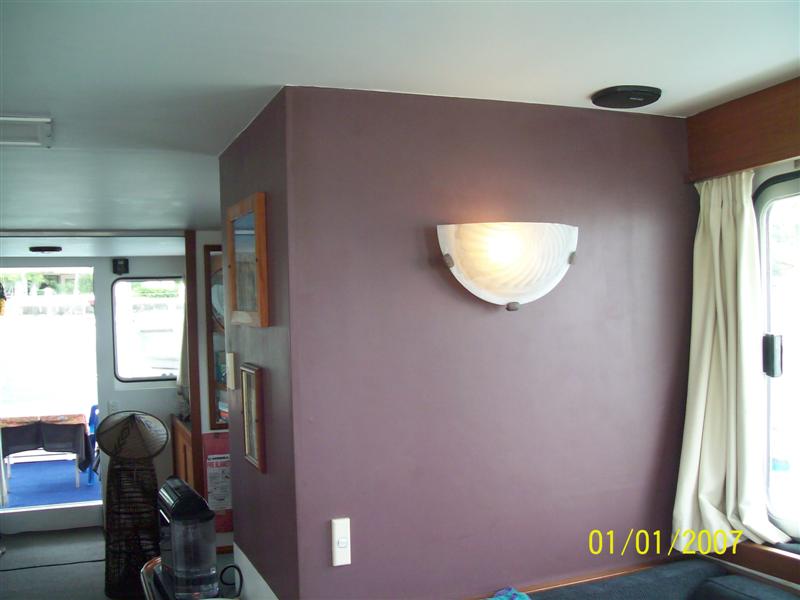
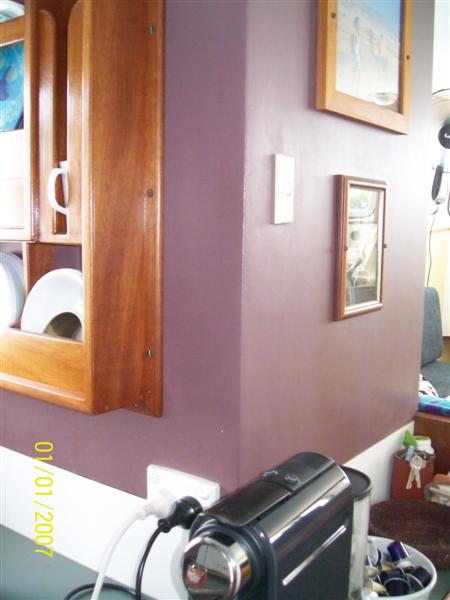 2. All power sockets and light switches are familiar domestic types, located in just the places you’d find a domestic switch;
2. All power sockets and light switches are familiar domestic types, located in just the places you’d find a domestic switch;
3. Switching from ship’s power to shore power (or vice versa) requires only plugging in the shore power cable to a caravan-type plug and flipping a couple of switches at the switchboard.
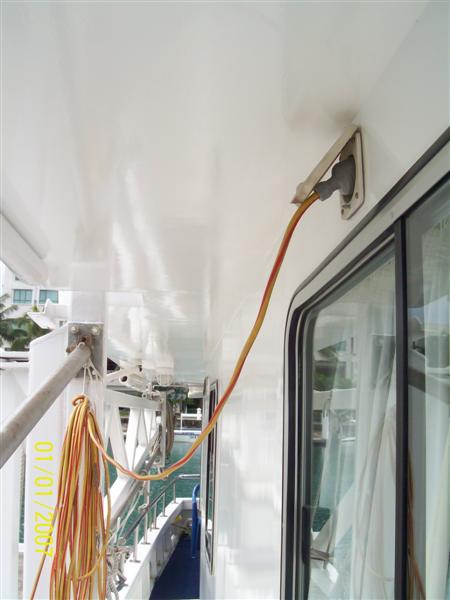
No extra cables and plugs where shore power voltage is different from the boat’s house voltage. And no complications like having to hitch up the shore power to a battery charger to charge the batteries for 12 volt equipment, while running other leads for 240v appliances.
For such a system to work, it is necessary to have an extremely efficient inverter. Some of these use as much as an amp merely to be ON. Our Latronics (800 watts 24 volt) inverter uses an infinitessimal amount of power when ON in standby mode. So if Lifeline is not in a marina, the inverter is switched on and stays on. Power is supplied apparently as though it were mains generated. (So it is important to put away all the high power appliances I use when on shore power like the toaster, jug, coffee machine etc Otherwise it is too easy to forget I am using battery power and need to be a power miser again.)
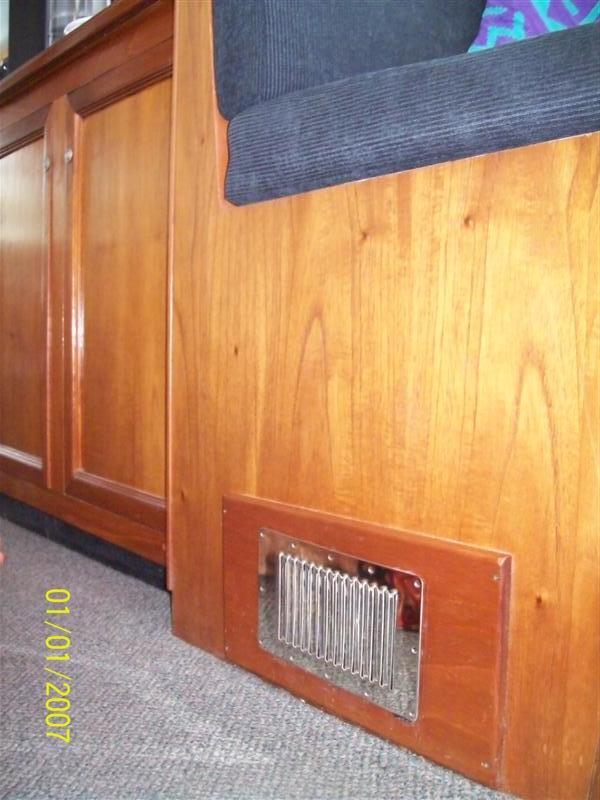 The inverter is located below the dinette seat*
The inverter is located below the dinette seat*
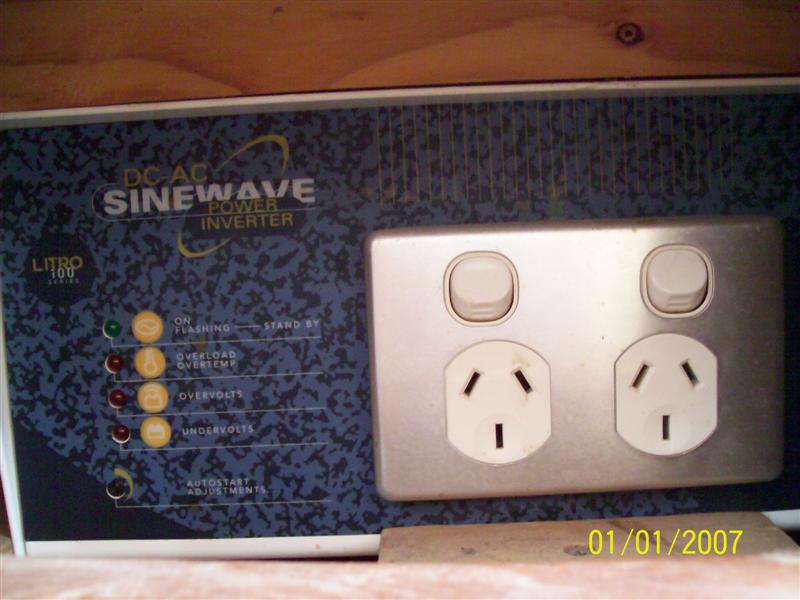 The inverter is wired directly into the boat's electrical system - no need for these power plugs.*
The inverter is wired directly into the boat's electrical system - no need for these power plugs.*
On a boat, refrigeration is one of the hungriest users of power. So it was especially important that our fridge/freezer was power efficient. Here we broke our pattern of using 240v domestic appliances. We chose not to have a normal domestic compressor driven refrigerator freezer simply because we couldn’t find one that was insulated efficiently. In a house people don’t care how much electricity they use because it is plentiful and cheap. So an inefficiently insulated fridge (which loses cold through its walls and therefore has to cycle on for longer) uses an unacceptably large amount of power in a low power budget system. In addition, in a front opening fridge the cold “falls out” every time the door is opened. So we wanted a top opening unit. However, as mentioned above, we did not want to use a eutectic refrigeration system.
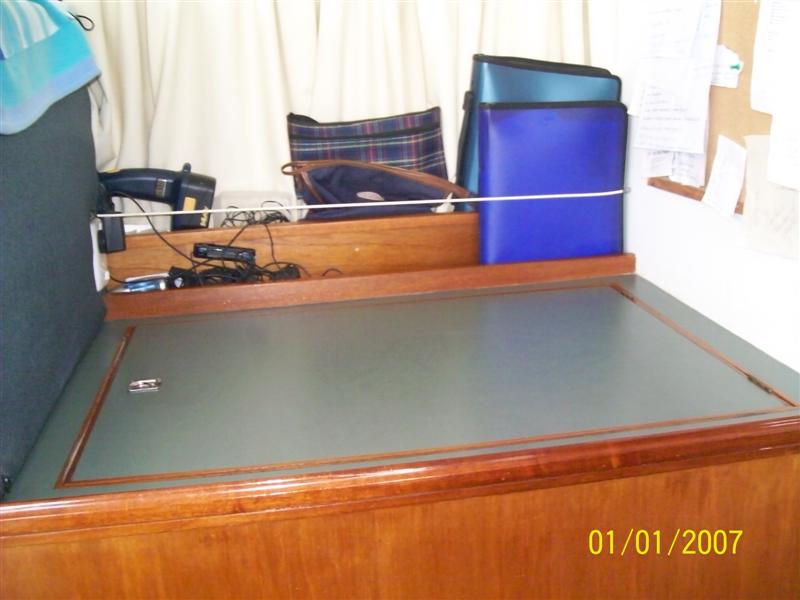 Lifeline's fridge freezer lurks below an opening "nav" table - just like on countless yachts. Size is one half chart.*
Lifeline's fridge freezer lurks below an opening "nav" table - just like on countless yachts. Size is one half chart.*
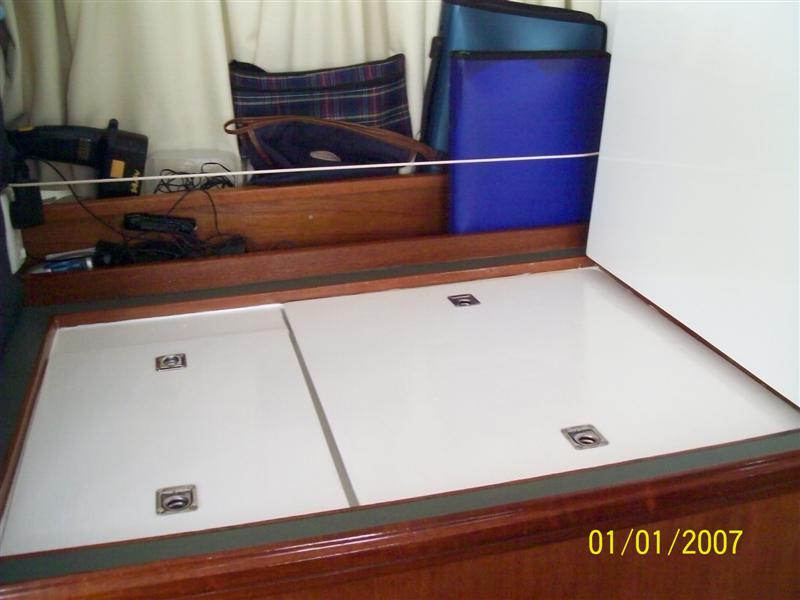 The lids of Lifeline's fridge and freezer boxes under the hinged chart table.*
The lids of Lifeline's fridge and freezer boxes under the hinged chart table.*
The answer for us was a 24 volt compressor driven system, custom designed so we could have the maximum amount of insulation for the small to moderate box sizes. Good insulation means the fridge/freezer cycles on less for a given temperature, using less power. We chose a simple, clever system designed by Moorebank Refrigeration of Sydney. Our freezer box is relatively small (See photo. Whiteboard marker indicates dimensions).
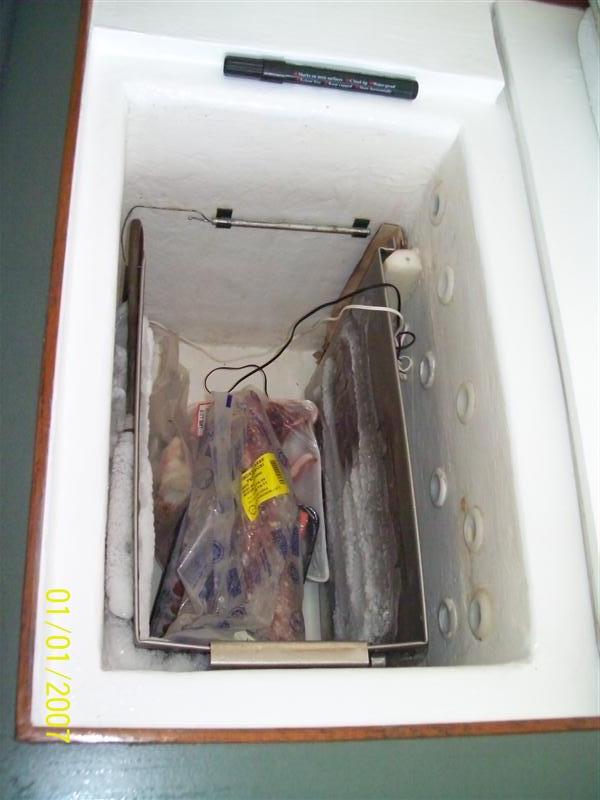 Freezer box. Note "holes cut into the side wall which leak cold air into the fridge compartment.*
Freezer box. Note "holes cut into the side wall which leak cold air into the fridge compartment.*
The refrigerator is 120 litres with a lift out basket. For energy efficiency we used 5” of foam all around and made the boxes top opening. The plate is U-shaped, located in the freezer. Cold air “leaks" into the fridge compartment via half a dozen or so holes in the wall between the two boxes. The compressor is located in a vented locker beneath. This setup uses less than 2 amps when cycling on. How often it cycles depends on the ambient temperature and the desired temperature of the fridge freezer.
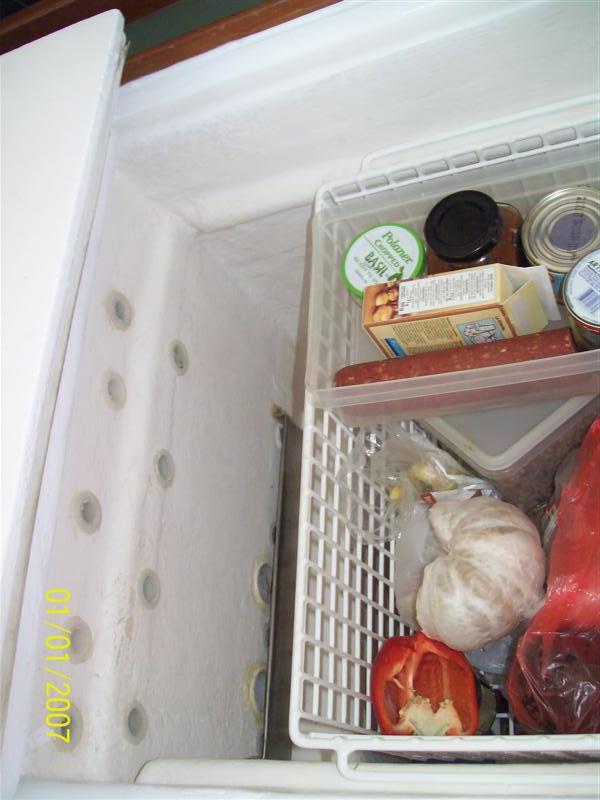 The fridge works purely on the effect of cold air leaking from the freezer box into the fridge box via several holes cut into the wall between the two compartments.*
The fridge works purely on the effect of cold air leaking from the freezer box into the fridge box via several holes cut into the wall between the two compartments.*
Daily the total current draw has been as much as 60 amps here in the tropics (where our fridge/freezer works overtime against the ambient temperatures), but 99% of the time well less than a quarter of the capacity of the house batteries.
Lifeline’s switchboard has a 12 volt panel, a 24 volt panel and a 240 volt panel, co-located at the helm station. Residual Current Device, SHIP/SHORE switch, Every wire is numbered and labeled and mapped to circuit diagrams.
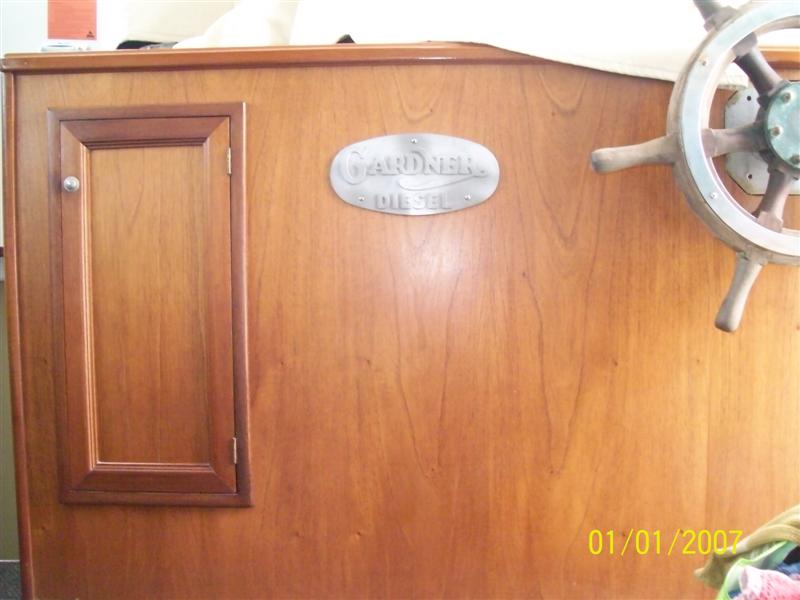
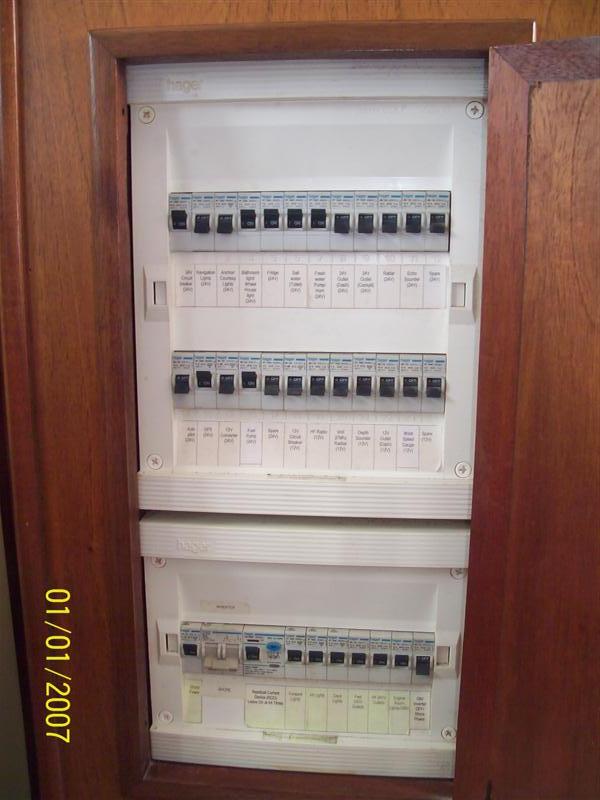 The switchboard is located close to the helm station. It is organised into 12, 24 and 240 volt panels and the safety control panel where type of power (shore or inverter) is selected.*
The switchboard is located close to the helm station. It is organised into 12, 24 and 240 volt panels and the safety control panel where type of power (shore or inverter) is selected.*
Backup Systems
The difference between Lifeline's permanent system and the backup is that the backup is not built in - it’s temporary; and only gets used occasionally. So it doesn’t have to meet the same self sufficiency and liveability standards as the boat's permanent system.
For that reason Lifeline carries a 24volt petrol generator (on the roof), which can be connected to the batteries (via 5m battery leads through a port to the engineroom) to charge them if necessary. It's noisy and cumbersome but has got us out of a spot three times in 10 years, when constant rainy weather for many days meant the solar panels couldn’t do their job and we didn’t feel like motoring.
Also on board is a 24 volt battery charger that could be used where there is shore power to keep the batteries topped up to run the fridge if ever something happened to the solar panels. (In 2010 I broke out the battery charger for the first time whilst on the slip in Borneo where a shady tree overhung the solar panels.)
What’s more, at some stage this year I may buy a 240v petrol generator to run power tools etc on odd occasions at anchor. Normally such maintenance jobs are saved for the times Lifeline is berthed in a marina and has access to shore power. But there are jobs (eg grinding rust from metal) that are socially unacceptable to carry out near other boats. A generator like this could also back up Lifeline’s inverter. Fortunately here in Southeast Asia, portable generators like this are so ridiculously inexpensive it’s silly not to have one.